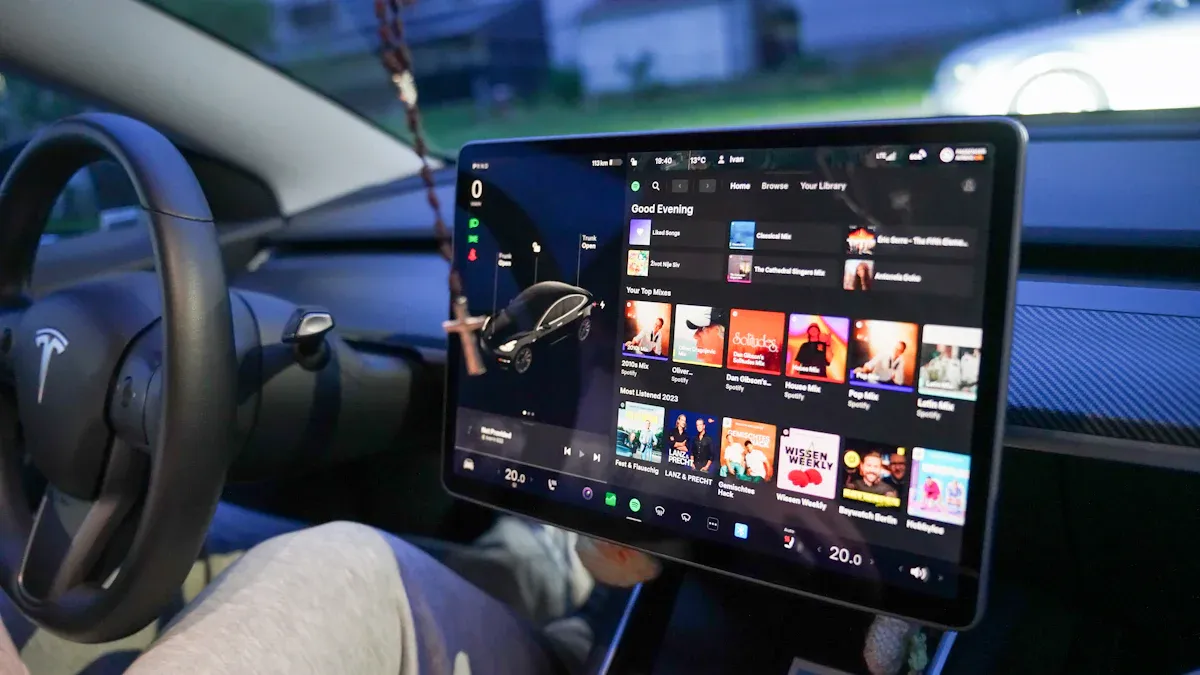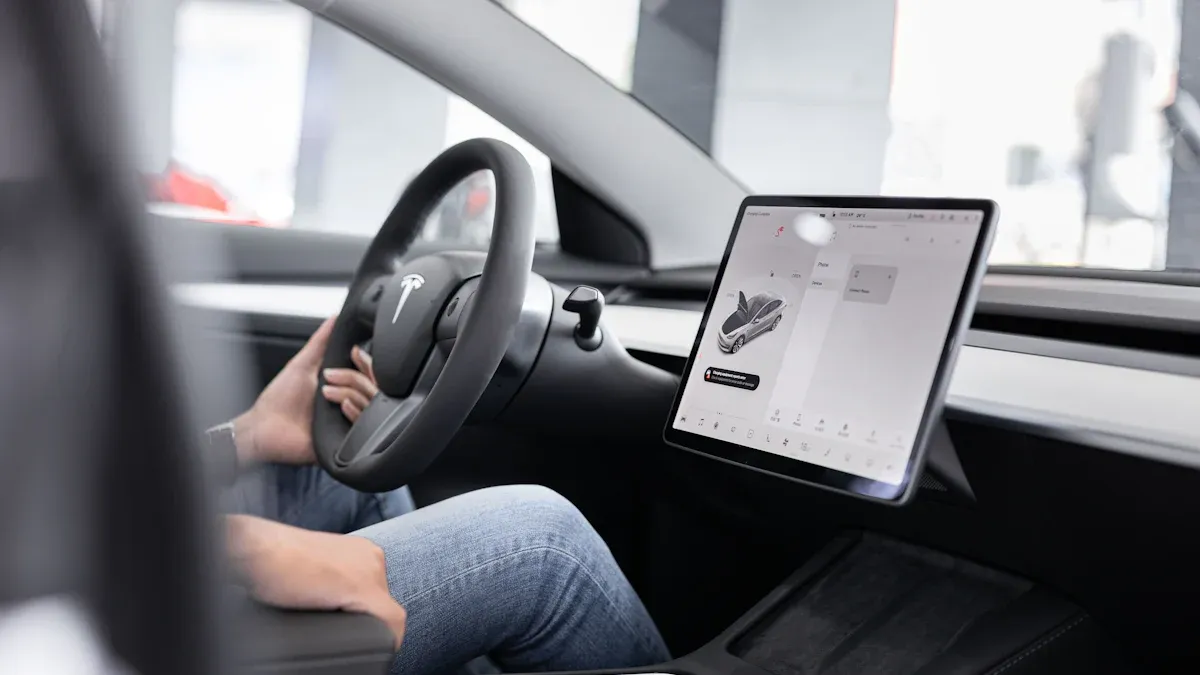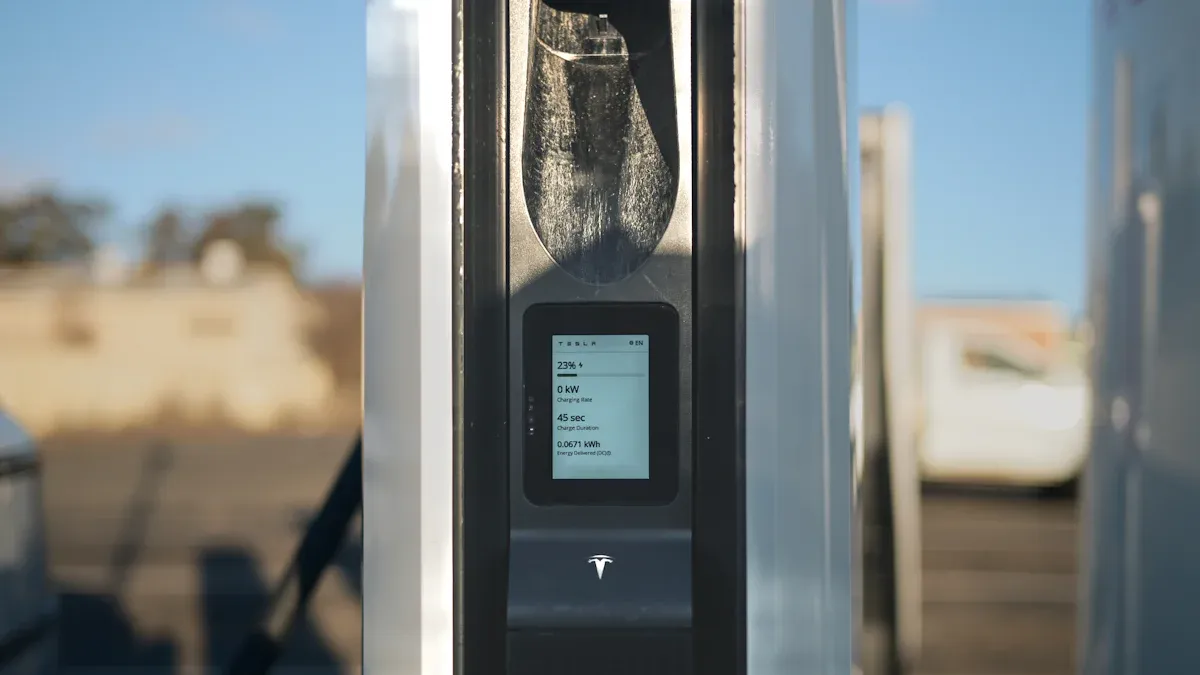How LCD Screens Enhance User Interaction at EV Charging stations

Imagine a driver arriving at an EV charging station, seeking quick updates and easy-to-follow instructions. LCD screens now play a vital role in the EV charging process, offering clear display and robust user experience at every step. EV owners interact with LCD displays for real-time updates, secure transactions, and a seamless charging experience. The rise of LCD display technology transforms EV charging stations into efficient, user-friendly spaces, making every EV charging session more convenient.
Key Takeaways
LCD screens can provide clear, easy-to-use interfaces that simplify EV charging for all users, including those with disabilities.
High-brightness, anti-glare displays ensure visibility outdoors, delivering real-time updates and smooth interaction in any weather.
Durable and weather-resistant LCDs withstand harsh conditions and heavy use, offering long-lasting, reliable performance.
Secure payment options and strong data protection keep transactions safe and build user trust at charging stations.
Remote management and smart monitoring reduce maintenance costs and improve charging station efficiency for operators.
User Experience

Intuitive Interfaces
EV drivers often encounter challenges at charging stations. Common complaints include confusing payment processes, unclear error codes, and unreliable equipment. These issues can disrupt the charging experience and cause frustration. LCD TFT displays into EV charging systems are designed to address these pain points. These displays offer user-friendly interfaces that simplify every step of electric vehicle charging.
LCD TFT displays present clear menus, large icons, and readable text. Users can easily start or stop charging, select charging speeds, and complete payments. The flawless user interface reduces confusion and supports intuitive user interaction. Touch capability allows users to navigate options quickly, even when wearing gloves or in wet conditions. This accessibility benefits drivers with different physical and cognitive abilities, making EV charging stations more inclusive.
Note: LCD TFT displays support both capacitive and resistive touch, ensuring reliable operation in various environments.
User-friendly charging infrastructure relies on clear information architecture. LCD screens use high-contrast colors and proper text hierarchy, which lowers cognitive load and helps users of all ages and backgrounds. Iconography and visual cues guide users through each step, while optional voice prompts and alerts assist those with visual or hearing impairments. These features create a seamless charging experience for every EV owner.
Real-Time Updates
Real-time feedback is essential for a positive charging experience. LCD TFT displays deliver instant updates on charging status, charging time remaining, and transaction progress. Drivers see exactly how much energy their EV has received and how much longer the session will take. This transparency helps users plan their time and reduces anxiety about electric vehicle charging.
High brightness and anti-glare technology ensure that LCD TFT displays remain readable in all lighting conditions. Outdoor EV charging LCD panels reach to 1500 nits, maintaining visibility even under direct sunlight. Matte coatings and optical bonding reduce reflections, so users can view instructions and updates without distraction. These features are crucial for outdoor charging stations, where lighting can change throughout the day.
LCD TFT displays also support dynamic content. Operators can display educational messages about sustainability, safety tips, or promotional offers. This flexibility enhances the overall experience and keeps users engaged during their charging session.
Key benefits of BOE’s LCD TFT displays at EV charging stations:
Clear, interactive menus for easy navigation
Real-time updates on charging status and costs
High brightness and anti-glare for outdoor readability
Touch capability for intuitive user interaction
Accessibility features for diverse user groups
The integration of LCD technology transforms EV charging stations into modern, user-centric environments. Drivers enjoy a smoother, more reliable charging experience, while operators benefit from improved engagement and satisfaction.
EV Charging LCD Technology

Durability and Reliability
EV charging stations demand technology that can withstand constant use and harsh environments. LCD TFT displays deliver exceptional durability for commercial EV chargers. These displays use advanced materials and engineering to ensure long-term reliability. LCD TFT displays feature anti-bacterial glass, which helps maintain hygiene at public charging stations. This is especially important as many EV drivers interact with the screen daily.
LCD TFT screens also offer strong electromagnetic compatibility (EMC) performance. This reduces interference from nearby electronic devices, ensuring stable operation. The robust construction of LCD panels protects against impacts and vandalism, making them ideal for busy EV charging locations. Regular maintenance and temperature regulation further enhance the lifespan of LCD screens. BOE’s LCD technology supports continuous operation, providing a dependable solution for electric vehicle charging.
Note: LCD TFT screens are designed for high-traffic environments, supporting reliable performance even after thousands of charging sessions.
Outdoor Performance
Outdoor LCD displays at EV charging stations face extreme weather conditions. BOE’s EV charging LCD solutions use weather-resistant enclosures and proper ventilation to protect the display from rain, heat, and cold. Thermal sensors monitor temperature, while heat sinks and fans regulate internal conditions. Shading structures help reduce solar heating, and airflow design prevents water ingress while maintaining cooling efficiency.
LCD maintains outstanding visibility in all lighting conditions. High-brightness display technology ensures that users can read information clearly, even under direct sunlight. Outdoor LCD displays reach brightness levels up to 3500 nits, providing visibility at any time of day. Hydrophobic coatings and sealing techniques prevent moisture damage, supporting reliable operation in humid environments.
Key features of BOE’s EV charging LCD technology:
Weather-resistant enclosures for outdoor use
High-brightness display for outstanding visibility
Anti-bacterial glass for public hygiene
EMC performance for stable operation
Long lifespan for commercial EV chargers
BOE’s LCD screens set a new standard for EV charging LCD applications. They combine durability, reliability, and visibility, making them the preferred choice for modern EV charging infrastructure.
Security and Transactions
Safe Payments
EV charging stations must provide secure payment experiences for every user. LCD screens play a central role in this process. They display clear instructions and support multiple payment methods. Many systems use PCI-compliant payment terminals that work with EMV Chip & Pin, NFC contactless cards, Apple Pay, and Google Pay. These options allow drivers to pay quickly and safely without physical contact. LCD SCREENS also support PIN code entry, RFID authentication, and app-based identification. This variety gives users flexibility and confidence during each transaction.
Charging stations with LCD screens often include secure hardware features. Locked printer cases and weatherproof designs protect payment components from tampering and environmental damage. The user interface on the LCD guides drivers through each step, reducing errors and making payments simple. For example, some stations use backlit LCD displays with RFID access control, while others offer daylight-readable touchscreens for easy navigation. These features help ensure that every EV driver can complete a payment securely, even in busy or outdoor environments.
Tip: BOE’s LCD digital signage products support integration with advanced payment terminals, making them ideal for secure and user-friendly EV charging solutions.
Data Protection
Protecting user data is essential at every EV charging station. LCD-based payment systems use strong security protocols to prevent fraud and unauthorized access. Transport Layer Security (TLS) encryption protects data as it moves between the charging station and central management systems. Mutual authentication and digital certificates ensure that only authorized devices communicate with each other. The ISO 15118 standard enables secure Plug & Charge functionality, where vehicles and chargers authenticate using certificates.
Operators use real-time transaction monitoring and machine learning algorithms to detect suspicious activity. Two-factor authentication and pre-authorizations add extra layers of security. Some systems use RFID cards, while others rely on virtual tokens or Plug & Charge certificates for secure identification. Open Charge Point Protocol (OCPP) security profiles enforce secure communication, firmware update protections, and event logging. These measures work together to protect payment and user data, giving every EV driver peace of mind.
Operational Efficiency
Remote Management
EV charging stations require efficient management to ensure reliable service. LCD technology from BOE enables operators to monitor and control multiple EV chargers remotely. LCD screens provide real-time diagnostics, allowing early detection of software or connectivity issues. Operators can address problems before they disrupt service, which reduces the need for costly on-site maintenance. Automated fault recovery algorithms allow charging stations to self-heal common problems. This feature minimizes emergency repairs and limits downtime.
Operators use LCD displays to push remote firmware updates. These updates keep EV chargers optimized with new features and security patches. The process lowers manual maintenance efforts and ensures that every station remains up to date. Automated alert management operates around the clock, enabling quick troubleshooting and proactive responses. Bulk firmware updates and remote monitoring help maintain network efficiency. These capabilities reduce operational costs by avoiding reactive maintenance.
LCD screens support seamless integration with remote management platforms, making EV charging networks smarter and more reliable.
Smart Monitoring
Smart monitoring transforms the way operators and users interact with EV charging stations. LCD displays act as the main human-machine interface, providing clear, real-time feedback on charging status, pricing, and operational controls. Users can monitor and manage their charging sessions through interactive touch functionality. High brightness and wide viewing angles ensure that information remains visible in any environment.
LCD displays also support real-time energy monitoring and smart grid integration. Operators can visualize electricity flow, monitor power quality, and detect faults instantly. This capability allows utilities to balance loads, respond to demand, and protect transformers from overloads. Smart grid solutions use LCD screens to display dynamic charging limits and total energy costs, supporting efficient energy use and grid stability.
Emerging Trend | Description |
|---|---|
Interactive LCD TFT Displays | Real-time charging info, multimedia content, and interactive features |
Operational Efficiency | IoT-enabled remote management and diagnostics |
Technological Innovations | Touch interfaces, fast charging, modular and energy-efficient designs |
Future Integrations | 5G, AI, augmented reality, smart home systems, renewable energy, V2G |
BOE’s LCD technology positions EV charging stations at the forefront of smart infrastructure. Operators benefit from reduced maintenance costs, while users enjoy a transparent and interactive charging experience.
Added Value
Advertising Potential
LCD screens at EV charging stations create new opportunities for advertising and revenue generation. Operators can use these digital displays to show dynamic content, including videos, animations, and real-time promotions. This approach transforms the charging wait into a valuable marketing moment.
Digital screens operate 100% of the time, maximizing monetization opportunities.
Both charging networks and site partners benefit from increased profitability.
The advertising market for charging station screens is growing rapidly, with global revenue expected to reach USD 5.2 billion by 2033.
High-traffic locations such as airports and malls make these screens prime advertising spaces.
Interactive touch screens increase consumer engagement, making advertisements more effective.
A recent case study shows that LCD screens engage a captive audience by delivering targeted advertising during the charging period. This method surpasses traditional static signage in both impact and adaptability. Operators can update content remotely, ensuring that advertisements remain timely and relevant. The ability to collect user interaction data allows for data-driven advertising strategies, optimizing content and timing for maximum impact.
Branding and Customization
BOE’s LCD technology offer extensive customization options to meet diverse branding and customization needs at EV charging stations. Businesses can tailor the display to showcase logos, colors, and unique graphics, creating a strong brand presence.
High brightness ensures visibility even under direct sunlight.
Weather-resistant construction supports outdoor durability.
Customization features include the ability to schedule content, display animations, and present videos tailored to specific campaigns.
User-friendly content management systems allow easy updates and control over displayed content.
Multiple sizes, fit various installation requirements.
Customization of LCD screens enables businesses to align the technology with their brand identity and customer engagement strategies. Digital advertising on these screens can display targeted ads, exclusive promotions, and seasonal offers, increasing customer dwell time and encouraging repeat visits. Interactive features such as QR codes and feedback surveys further enhance brand affinity. Retailers can integrate branded LCD interfaces with loyalty programs and CRM systems, transforming charging stations into interactive marketing tools that foster stronger customer relationships.
Tip: Evolving digital displays support real-time data integration, modular design, and future-proofing, making LCD solutions ideal for operators seeking to differentiate their stations and deliver a superior user experience.
LCD display technology transforms EV charging stations. LCD screens deliver clear interfaces, secure transactions, and efficient operations. Users benefit from real-time updates and reliable performance. Operators see improved management and new revenue streams.
LCD ensures visibility in any environment
Advanced features support safety and hygiene
Customization strengthens brand identity
BOE leads the way in LCD innovation. Future EV infrastructure will rely on smarter, more interactive displays to shape the next era of electric mobility.
FAQ
What makes LCD SCREENS ideal for EV charging stations?
LCD SCREENS provide high brightness, durability, and clear visibility in outdoor environments. BOE designs LCD solutions for continuous operation and easy user interaction. These features ensure reliable performance at EV charging stations.
How do LCD SCREENS handle extreme weather conditions?
BOE LCD SCREENS use weather-resistant enclosures and advanced materials. High Tni liquid crystal and protective coatings help maintain display quality in heat, cold, rain, or sunlight. Operators trust LCD for outdoor reliability.
Can LCD SCREENS support secure payments at charging stations?
LCD SCREENS from BOE integrate with secure payment terminals. They display clear instructions for PIN, RFID, and contactless payments. Security protocols protect user data during every transaction.
Do LCD SCREENS require frequent maintenance?
LCD SCREENS from BOE feature long lifespans and robust construction. Operators benefit from remote diagnostics and software updates. This reduces the need for frequent on-site maintenance.
Tip: BOE LCD screens deliver reliable performance and easy management for modern EV charging infrastructure.
See Also
Deciding On LED Versus LCD Video Walls For Business
Understanding LCD Technology And Its Importance Explained
Exploring Differences Between OLED And LED Flexible Displays
An Introduction To UB Cell Display Technology Explained
LTPO Display Technology Powering Battery Life And Smooth Scrolling